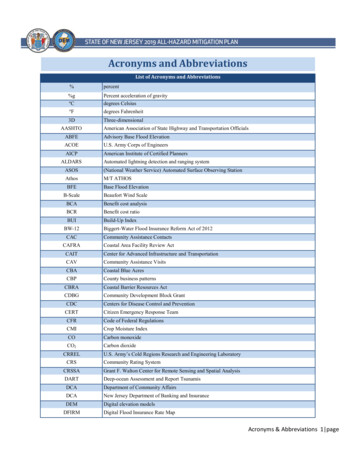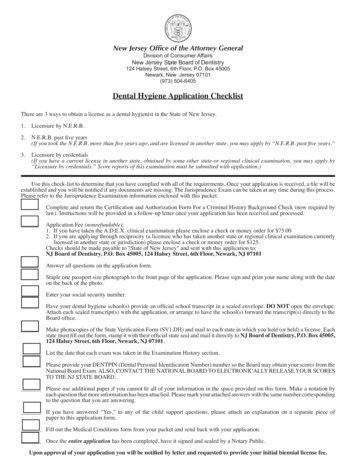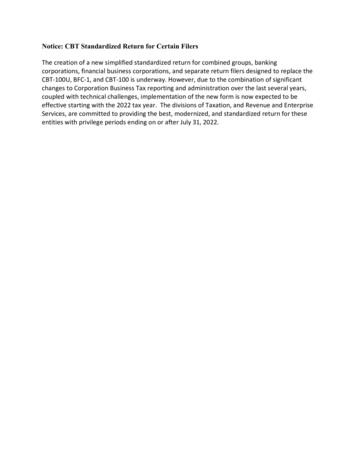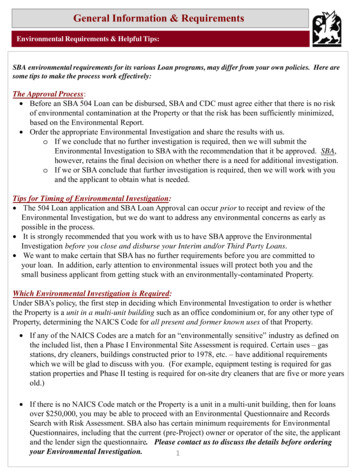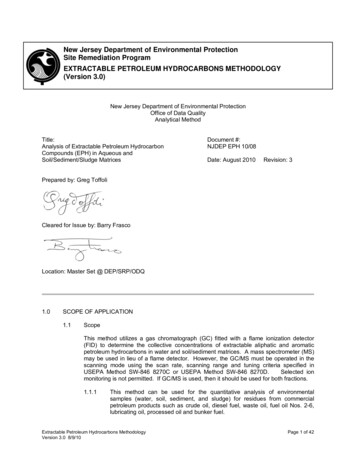
Transcription
New Jersey Department of Environmental ProtectionSite Remediation ProgramEXTRACTABLE PETROLEUM HYDROCARBONS METHODOLOGY(Version 3.0)New Jersey Department of Environmental ProtectionOffice of Data QualityAnalytical MethodTitle:Analysis of Extractable Petroleum HydrocarbonCompounds (EPH) in Aqueous andSoil/Sediment/Sludge MatricesDocument #:NJDEP EPH 10/08Date: August 2010Revision: 3Prepared by: Greg ToffoliCleared for Issue by: Barry FrascoLocation: Master Set @ DEP/SRP/ODQ1.0SCOPE OF APPLICATION1.1ScopeThis method utilizes a gas chromatograph (GC) fitted with a flame ionization detector(FID) to determine the collective concentrations of extractable aliphatic and aromaticpetroleum hydrocarbons in water and soil/sediment matrices. A mass spectrometer (MS)may be used in lieu of a flame detector. However, the GC/MS must be operated in thescanning mode using the scan rate, scanning range and tuning criteria specified inUSEPA Method SW-846 8270C or USEPA Method SW-846 8270D.Selected ionmonitoring is not permitted. If GC/MS is used, then it should be used for both fractions.1.1.1This method can be used for the quantitative analysis of environmentalsamples (water, soil, sediment, and sludge) for residues from commercialpetroleum products such as crude oil, diesel fuel, waste oil, fuel oil Nos. 2-6,lubricating oil, processed oil and bunker fuel.Extractable Petroleum Hydrocarbons MethodologyVersion 3.0 8/9/10Page 1 of 42
1.1.21.2This method shall not be used for the quantitative analysis of gasoline, mineralspirits, petroleum naphtha and other petroleum products which contain asignificant percentage of hydrocarbons lighter than C9 in water andsoil/sediment/sludge matrices at contaminated sites.Applicable ProgramsUnderground Storage Tanks (UST), New Jersey Spill Fund, ComprehensiveEnvironmental Response Compensation and Liability Act (CERCLA), Industrial SiteRecovery Act (ISRA), Sludge Residuals, and Resource Conservation and Recovery Act(RCRA).1.31.41.52.0Method Advantages1.3.1This method replaces the Total Petroleum Hydrocarbons (TPH) method basedon Freon 113 extraction and analysis by infrared spectroscopy (i.e., Method418.1).1.3.2The FID response produces extractable petroleum hydrocarbon (EPH)chromatograms that can be used to calculate concentrations of specifiedcarbon ranges for both aliphatic and aromatic fractions.1.3.3This method provides results for specific carbon number ranges in bothaliphatic and aromatic fractions of EPH thereby providing a more accurateassessment of potential health risk at environmental sites.1.3.4This method provides an option where extracts from samples may be analyzedwithout having to be fractionated.Method Limitations1.4.1Lower boiling hydrocarbons may co-elute with extraction solvents.1.4.2The EPH measured by this method is quantitatively restricted to the semivolatile components as partial loss of volatiles (including those compoundslighter than C9) occurs during the extraction and/or concentration process.1.4.3The gas chromatographic conditions are not designed for samples containingEPH with carbon numbers greater than C44.Applicable Matrices1.5.1Surface water, ground water, and wastewater.1.5.2Soil, sediments or high solids sludge ( 50%).SUMMARY OF METHOD2.1This quantitative EPH method is adopted from the "Method for the Determination ofExtractable Petroleum Hydrocarbons (EPH)," Massachusetts Department ofEnvironmental Protection (1); the "Method for the Determination of Extractable PetroleumHydrocarbons (EPH) Fractions," Washington State Department of Ecology (2); the"Leaking Underground Fuel Tanks Field Manual" of the California State Water ResourcesControl Board (3); "Test Methods for Evaluating Solid Waste" USEPA Method 8015B (4);Extractable Petroleum Hydrocarbons MethodologyVersion 3.0 8/9/10Page 2 of 42
"Method for the Determination of Total Petroleum Range Organics," Florida Departmentof Environmental Protection (5); and "Quantitation of Semi-Volatile Petroleum Products inWater, Soil, Sediment and Sludge," New Jersey Department of Environmental ProtectionOQA-QAM-025-02/08 (6).2.2This method is adapted with modifications from ASTM Method D3328-82 and the USCoast Guard Oil Spill Identification Procedure for Total Petroleum (7, 8).2.3Petroleum residues are extracted from sample matrices with methylene chloride, driedover sodium sulfate, solvent exchanged to hexane and concentrated in a KudernaDanish apparatus. However, if a non-aqueous sample is known to be contaminated with#2 fuel/diesel or the concentration of a non-#2 fuel/diesel petroleum product in a nonaqueous sample has been determined by this method to be below the number generatedby the EPH calculator when it is assumed that 100% of the contamination is in the carbonrange with the most conservative toxicity factor (as of June 1, 2010, the number is 1700mg/Kg, subject to change), then solvent exchange and fractionation are not required.Additionally, aqueous samples are not required to undergo solvent exchange andfractionation. Quantitation for non-fractionated samples is performed using the total areaof all peaks present and dividing the chromatography into the eight carbon ranges is notrequired. For all other instances, the extracts are separated into aliphatic and aromaticfractions using silica gel columns, either commercially available or lab prepared. Each ofthe aliphatic and aromatic fractions are re-concentrated and subsequently analyzedseparately by capillary column GC/FID. Each of the resultant chromatograms of thealiphatic and aromatic fractions are used to quantitate four distinct carbon numberranges. Each carbon number range is defined using equivalent carbon (EC) numbers.The EC number is related to a compound's boiling point and retention time on a gaschromatography column normalized to the actual carbon numbers of n-alkanes. Forexample, the EC of acenaphthylene is 15.06 because its boiling point and GC retentiontime are halfway between those of n-tetradecane (a straight 14-carbon chain compound)and n-hexadecane (a straight 16-carbon chain compound). The EC numbers are usedbecause they are more closely related to environmental mobility. The four EC numberranges for the aliphatic fractions are: EC9 to EC12, EC12 to EC16, EC16 to EC21 andEC21 to EC40. Similarly, the resultant chromatograms of the aromatic fractions are usedto quantitate four distinct carbon number ranges. The four carbon number ranges for thearomatic fractions are: EC10 to EC12, EC12 to EC16, EC16 to EC21 and EC21 to EC36.Surrogate compounds are added to all samples before extraction and their recoveries aremonitored. Percent recoveries for the surrogates can be expected to be in the 50 - 90 %range. If fractionation is required, then fractionating surrogates are added to the hexaneextract just prior to fractionation to monitor the efficiency of the fractionation process.Percent recoveries for the fractionating surrogates should be between 40% – 140 %.2.3.1The EPH concentration is determined by integration of the FID chromatogram(see section 11.2). Average calibration factors or response factors using thealiphatic standard mixture are used to calculate the concentration of eachcarbon range. Average calibration factors or response factors using thearomatic standard mixture are used to calculate the concentration of eachcarbon range. Concentrations of each carbon range from both fractions aresummed for a total EPH concentration.2.3.2For extracts not undergoing fractionation, the concentration is determined byintegration of the FID chromatogram (see section 11.3). Average calibrationfactors or response factors using the standard mixture are used to calculate theconcentrations.Extractable Petroleum Hydrocarbons MethodologyVersion 3.0 8/9/10Page 3 of 42
2.3.3The sensitivity of the method may be dependent on the level of interferencerather than on instrumental limitations. The quantitation limit for each carbonrange in soil is approximately 10 mg/kg and in water 100 ug/L.2.3.4Approximate Dynamic Range2.3.4.1EPH, both Fractionated and Non-fractionated SamplesSoil 80 -16000 mg/kgAqueous 0.8 - 160 mg/L2.3.4.2Individual Carbon RangesSoil 10 - 2000 mg/kgAqueous 0.10 - 20 mg/L2.4Compounds2.4.1Aliphatic Hydrocarbon StandardAliphatic Hydrocarbon (EC #)n-Nonane (C9)n-Decane (C10)n-Dodecane (C12)n-Tetradecane (C14)n-Hexadecane (C16)n-Octadecane (C18)n-Eicosane (C20)n-Heneicosane (C21)n-Docosane (C22)n-Tetracosane (C24)n-Hexacosane (C26)n-Octacosane (C28)n-Triacontane (C30)n-Dotriacontane (C32)n-Tetratriacontane (C34)n-Hexatriacontane (C36)n-Octatriacontane (C38)n-Tetracontane (C40)2.4.2Aromatic Hydrocarbon StandardAromatic Hydrocarbon (EC #)Acenaphthene (C15.5)Acenaphthylene (C15.06)Anthracene (C19.43)Benzo[a]anthracene (C26.37)Benzo[a]pyrene (C31.34)Benzo[b]fluoranthene (C30.14)Benzo[g,h,i]perylene (C34.01)Benzo[k]fluoranthene (C30.14)Chrysene (C27.41)Dibenz[a,h]anthracene (C30.36)Fluoranthene (C21.85)Fluorene (C16.55)Indeno[1,2,3-cd]pyrene (C35.01)2-Methylnaphthalene (C12.89)Extractable Petroleum Hydrocarbons MethodologyVersion 3.0 8/9/10Page 4 of 42
Naphthalene (C11.7)Phenanthrene (C19.36)Pyrene (C20.8)1,2,3-Trimethylbenzene (C10.1)2.5#2 Diesel Fuel StandardThe standard used for the LCS for #2 Fuel/Diesel analyses is #2 Diesel Fuel (availablefrom Restek (item 31233), Supelco and NSI Solutions)3.04.0INTERFERENCES3.1Method interferences are reduced by washing all glassware and then rinsing with tapwater, distilled water, methanol, and methylene chloride.3.22High purity reagents such as Burdick and Jackson GC methylene chloride, Bakercapillary grade methylene chloride or equivalent must be used to minimize interferenceproblems.3.3Before processing any sample, the analyst shall demonstrate daily, through the analysisof a method blank, that the entire system is interference-free.3.4Matrix interferences may be caused by contaminants that are co-extracted from thesample. The extent of matrix interference will vary considerably from source to source(e.g., fatty acids, biogenic materials, oxidized biodegradation products), depending uponthe nature and diversity of the site being sampled. The silica gel cleanup procedure,USEPA SW-846 Method 3630B, can be used to overcome many of these interferencesbut unique samples may require additional cleanup approaches such as SW-846Methods 3610B, 3620B and 3660B to achieve the necessary analytical sensitivity.3.5Naturally occurring alkanes may be detected by this method and may interfere withproduct identification. Naturally occurring plant waxes include predominantly odd carbonnumber alkanes from n-C25 through n-C35, and exhibit a dominant odd/even chainlength distribution.SAFETY4.1The toxicity or carcinogenicity of each reagent used in this method has not been definedprecisely. Each chemical compound should be treated as a potential health hazard.Exposure to these chemicals must be reduced to the lowest possible level by whatevermeans available. The laboratory is responsible for maintaining a current awareness fileof Occupational Safety and Health Administration (OSHA) regulations regarding the safehandling of the chemicals specified in this method. A reference file of material safetydata sheets (MSDS) should also be made available to all personnel involved in thechemical analysis. Additional references to laboratory safety are available and havebeen identified for use by the analyst (9, 10).Extractable Petroleum Hydrocarbons MethodologyVersion 3.0 8/9/10Page 5 of 42
5.0APPARATUS AND EQUIPMENT5.15.25.3Sampling Containers5.1.1Prior to use, wash bottles and cap liners with aqueous detergent solutions andrinse with tap water, distilled water, and methylene chloride. Allow the bottlesand containers to air dry at room temperature, place in a 105oC (minimumtemperature) oven for one hour, then remove and allow them to cool in an areaknown to be free of organic analytes.5.1.2Screw cap bottle - 40 mL PTFE-faced silicone cap liners.5.1.3Narrow mouth bottles - 1 liter, amber, PTFE faced silicone cap liners.5.1.4Wide-mouth glass jar-four ounce, amber, PTFE faced silicone cap liners.Glassware5.2.1Serum bottles - 100 mL, 10 mL, 2 mL crimp-top, PTFE-faced silicone capliners.5.2.2Pasteur pipettes.5.2.3Screw-cap Erlenmeyer flasks - 250 mL, with PTFE faced silicone cap liners.5.2.4Volumetric flasks - 10 mL, 25 mL, 100 mL.5.2.5Kuderna-Danish apparatus (KD), 500 mL flask.5.2.6Separatory funnels - 2 L Pyrex, Teflon stopcock.5.2.7Soxhlet Extractor with 500 mL flask.5.2.81 cm I.D. by 10 to 20 cm long glass column with glass or Teflon stopcock.Apparatus5.3.1Analytical balance capable of accurately weighing 0.0001 g.5.3.2A gas chromatograph with split/splitless injector, equipped with a capillarycolumn, capable of temperature programming. The analytical column chosenmust adequately resolve the n-C9 to n-C40 aliphatic standard compounds andthe aromatic standard compounds listed in 6.8.1 and 6.8.2 below. Therecommended column is:5.3.2.1Column - 30m long x 0.32mm I.D., 0.25um film thickness, 95%dimethyl-5% diphenyl polysiloxane (Restek RTX-5 or equivalent).Recommended Conditions:oooOven Temperature: 60 C; hold for 1 minute; 8 /minute to 290 C,hold for 7 minutesInjection size: 1 - 4 uLGas Flow Rates: Carrier Gas - Helium @ 2 -3 mL/minute;Oxidizer - Air @ 400 mL/minute;Fuel - Hydrogen @ 35 mL/minute;Make up - Air @ 30 mL/minute.Extractable Petroleum Hydrocarbons MethodologyVersion 3.0 8/9/10Page 6 of 42
Injection Port Temperature: 285oCColumn Inlet Pressure 15 p.s.i.Detector Temperature: FID @ 315oCLinear Velocity: 50 cm/sec5.3.2.26.0Detector - Flame Ionization Detector is required.5.3.3An autosampler is recommended.5.3.4Boiling chips (Teflon preferred) - Solvent extracted approximately 10/40mesh.5.3.5Water bath - Top, with concentric ring cover, capable of temperature control.The bath should be used in a hood.5.3.6Gas-tight syringe - One milliliter (mL) with chromatographic needles.5.3.7Microsyringes - l0uL, 100uL, 200uL.5.3.8Magnetic stirrer and 2-inch Teflon coated stirring bars.5.3.9Nitrogen concentration system composed of a precleaned pasteur pipette, witha small plug of glass wool (previously washed with solvent and dried) loaded atthe tip end, and filled with approximately 1-2 cm of precleaned alumina. Thetop of the pipette is attached to a hydrocarbon free nitrogen gas source usingprecleaned Teflon tubing. This concentration step should be performed atroom temperature or lower to retain light end compounds.REAGENTS6.1Purity of Reagents - Reagents are to be of the highest quality appropriate and shallconform to all pertinent specifications of the American Chemical Society.6.2Reagent water - Reagent water is defined as a water in which an interference is notobserved at the MDL of each parameter of interest (ASTM Specification D1193, Type ii).6.3Methylene chloride, methanol, carbon disulfide and hexane - pesticide grade, Burdick2and Jackson GC , Baker Capillary Grade or equivalent.6.4Sodium sulfate - (ACS) granular, anhydrous. Purify by heating at 400oC for four hours ina shallow tray, cool in a desiccator and store in a sealed glass bottle.6.5Silica gel desiccant (for fractionation) - 100/200 mesh (Davison Chemical Grade 923 orequivalent). Before use, activate for at least 16 hours at 130oC in a shallow glass traythat is loosely covered in foil. Cool and store as in section 6.4. Commercially availableSolid Phase Extraction (SPE) cartridges (20 ml tube volume/5 g bed weight) may be used(Restek - Massachusetts TPH Specialty SPE Cartridge or equivalent). (Please note:Silica gel is hygroscopic. Unused cartridges must be stored in properly maintaineddesiccators prior to use to prevent absorption of moisture from air.)6.6Ottawa and/or masonry sand, free from extractable petroleum products, may be used inlieu of sodium sulfate where applicable (such as for sections 9.2.1 and 9.2.2.2)6.7Hydrochloric acid, 1:1 - Mix equal volumes of (ACS grade) concentrated HCl and distilledwater.Extractable Petroleum Hydrocarbons MethodologyVersion 3.0 8/9/10Page 7 of 42
6.8Standard Solutions6.8.1Aliphatic Hydrocarbon Stock Standard - Prepare a hexane solution containingat a minimum the aliphatic compounds listed in Section 2.4.1, naphthalene, 2methylnaphthalene and the surrogates (1-chlorooctadecane and orthoterphenyl) each at a concentration of 1 mg/ml. (Naphthalene and 2methylnaphthalene are added to the aliphatic standard as their presence in thelaboratory control sample and/or laboratory control sample duplicate is used todetermine if fractionation for a batch is acceptable. Ortho-terphenyl is added toallow for surrogate recovery calculations from those extracts not undergoingfractionation.) For those extracts undergoing fractionation, the area from thesurrogate ortho-terphenyl is not used in aliphatic calculations. Aliphaticmixtures are available from Supelco, Restek (Cat. # 31266), NSI Solutions andUltrex. (Note: Due to the commercial availability of standards, it may benecessary to combine two commercially available standard mixtures whichmay result in the addition of compounds such as n-Nonane (C9) and nNonadecane (C19) to the aliphatic hydrocarbon standard.)6.8.2Aromatic Hydrocarbon Stock Standard - Prepare a methylene chloride solutioncontaining the aromatic compounds listed in Section 2.4.2, the surrogatecompound (ortho-terphenyl) and the fractionating surrogate compounds (2Bromonaphthalene and 2-Fluorobiphenyl) each at a concentration of 1 mg/ml.(Aromatic mixtures are available from Supelco, Restek (Cat. # 31469), NSISolutions and Ultrex.)6.8.3Surrogate - The surrogate ortho-terphenyl (OTP) is prepared by weighing0.0100 g of pure material in a 10 mL volumetric flask. Dissolve the material tovolume in methylene chloride. The surrogate 1-chlorooctadecane (COD) isprepared by carefully weighing 0.0100 g of pure material in a 10 mL volumetricflask. Dissolve the material to volume with hexane. (Surrogate solutions areavailable from Restek Inc. [11].)6.8.4Surrogate Spiking Solution - Prepare a surrogate spiking solution containingOTP and COD at a concentration of 100 ng/uL each in acetone. Each sample,blank, and matrix spike is fortified with 1.0 ml of the surrogate spiking solution.Alternative concentrations are permissible and, in instances when spikinghighly contaminated samples, the use of higher concentrations is advisable.6.8.5Laboratory Control Sample (LCS) (Blank Spike) Solution - The LCS solution isthe same as the matrix spiking solution described in 6.8.6 below. 1 mL is usedto fortify either reagent water or clean sand (or sodium sulfate).6.8.6Matrix spiking solution (MSS) - Prepare the MSS containing all the compoundsin sections 2.4.1 and 2.4.2 in pentane each at a concentration of 100 ng/uL.The source of the standards shall be different than those from which thecalibration standards are made. A 1 mL aliquot is added to the sampledesignated as the matrix spike. Alternative concentrations are permissibleand, in instances when spiking highly contaminated samples, the use of higherconcentrations is advisable. (Matrix spiking solutions are available fromRestek.)6.8.7Fractionating Surrogates: The fractionating surrogates (2-Bromonaphthaleneand 2-Fluorobiphenyl) are prepared by weighing 0.0100 g of pure material in a10-ml volumetric flask and dissolving the material in Methylene Chloride.(Surrogates are available from Restek Inc.)Extractable Petroleum Hydrocarbons MethodologyVersion 3.0 8/9/10Page 8 of 42
6.8.8Fractionating Surrogate Spiking Solution - Prepare the solution containing 2Bromonaphthalene and 2-Fluorobiphenyl at concentrations of 100 ng/ul each inhexane. An aliquot of 1 ml of the fractionating surrogate spiking solution isadded to the 1 ml EPH sample extract prepared in accordance with sections10.1 and 10.2 just prior to fraction separation with silica gel. Alternativeconcentrations are permissible and, in instances when spiking highlycontaminated samples, the use of higher concentrations is advisable.6.8.9Fractionating Check Solution - This solution is used to monitor the fractionationefficiency of the silica gel cartridge/column and establish the optimum hexanevolume required to efficiently elute the aliphatic fraction without significantaromatic breakthrough.Prepare the solution containing 200 ng/uL of all the compounds listed in thealiphatic hydrocarbon standard and 200 ng/uL of all the compounds listed inthe aromatic hydrocarbon standard cited in sections 6.8.1 and 6.8.2respectively, in hexane.7.06.8.10#2 Fuel/Diesel Laboratory Control Sample (LCS) (Blank Spike) Solution –Prepare a #2 Diesel fuel (purchased from an analytical standards provider suchas Supelco, cat. # 31233) in methylene chloride at a recommendedconcentration of 250 ng/uL) 1 mL is used to fortify either reagent water or cleansand (or sodium sulfate).6.8.11#2 Diesel Fuel Standard (Optional). Prepare in methylene chloride a standardof # 2 Diesel fuel at a recommended concentration of 250 ng/uL and OTP andCOD at concentrations of 100 ng/uL. This standard may be used to determinethe recoveries of the #2 Fuel/Diesel LCS and LCSDs in lieu of using theAliphatic Hydrocarbon Standard.SAMPLE COLLECTION, PRESERVATION AND STORAGE7.1Aqueous Matrix7.1.1Collect a representative water sample in a 1 L narrow mouth bottle. A delaybetween sampling and analysis of greater than four hours requires samplepreservation by the addition of 5 ml HCl (see section 6.7). Confirmation of a pH 2 must be obtained in the field.7.1.2ooSample must be chilled to 4 2 C at the time of collection and stored at 4 2 Cuntil received at the laboratory.7.1.3The laboratory must determine the pH of all water samples as soon as possibleafter sample receipt and prior to extraction. Any sample found to contain a pH 2 must be noted in a laboratory notebook and the pH must be adjusted assoon as possible. Samples are to be stored at 4 2oC until extraction.7.1.4Samples must be extracted within fourteen days from the time of collection.Extracts must be analyzed within 40 days of extraction.Extractable Petroleum Hydrocarbons MethodologyVersion 3.0 8/9/10Page 9 of 42
7.28.0Solid Matrix7.2.1Collect a representative soil-sediment sample in a four-ounce, wide-mouth jarwith a minimum of air space.7.2.2Samples must be chilled at 4 2oC at the time of collection and stored at 4 2oCuntil analyzed.7.2.3Samples must be extracted within fourteen days from the time of collection.Extracts must be analyzed within 40 days of extraction.CALIBRATION8.1Initial Calibration for samples undergoing fractionation8.1.18.1.2Retention time windows8.1.1.1Before establishing windows, make sure the GC system is withinoptimum operating conditions. Make three injections of theAromatic Hydrocarbon and Aliphatic Hydrocarbon standardmixtures. Serial injections over less than a 72 hr period result inretention time windows that are too restrictive.8.1.1.2Calculate the mean and the standard deviation ofretention times (use any function of retention timeabsolute retention time or relative retention time)individual compound in the aromatic standard, eachcompound in the aliphatic standard and all surrogates.8.1.1.3Plus or minus three times the standard deviation of the meanretention times for each compound in the aromatic and aliphaticstandards will be used to define the retention time window;however, the experience of the analyst should weigh heavily in theinterpretation of chromatograms.The default value for theretention time shall be a minimum of 0.1 minutes, if the standarddeviation is zero or close to zero.8.1.1.4Establish the midpoint of the retention time window for eachsurrogate by using the absolute retention for each surrogate fromthe mid-concentration standard of the initial calibration. Theabsolute retention time window equals the midpoint 3 SD, wherethe standard deviation is determined as described in section8.1.1.2.8.1.1.5The laboratory must calculate retention time windows for eacharomatic standard compound, each aliphatic standard compoundand each surrogate on each GC column and whenever a new GCcolumn is installed. The data must be retained by the laboratory.the threeincludingfor eachindividualFID External Standard Calibration for Quantitation of EPH. - Calibrate the GCFID with an initial five-point calibration.The recommended standardconcentrations of each individual component are 20 ng/uL, 100 ng/ul, 250ng/uL, 500 ng/uL and 1000 ng/uL. Separate calibrations are to be conductedfor each fraction (see sections 6.8.1 and 6.8.2). The highest concentrationExtractable Petroleum Hydrocarbons MethodologyVersion 3.0 8/9/10Page 10 of 42
point should be twice the expected sample concentration and within the linearrange of the instrument. To maintain the standards in solution, a 10% carbondisulfide / 90% methylene chloride solvent may be required. Standards withconcentrations greater than 20 mg/L may need to be equilibrated to roomtemperature prior to analysis. Prepare the calibration standards to contain thesurrogates at the same concentrations as the individual components. Thesurrogate OTP and the fractionating surrogates are included in the AromaticHydrocarbon Standard. The surrogates COD and OTP are included in theAliphatic Hydrocarbon Standard.A calibration factor (CF) must be established for each individual component.Also, a separate calibration factor (CF) must be established for each carbonrange of interest. Calculate CFs for the C9-C12, C12-C16, C16-C-21 and C21C40 Aliphatic Hydrocarbon carbon ranges from the appropriate aliphaticanalysis chromatogram. Calculate CFs for C10-C12, C12-C16, C16-C-21 andC21-C36 Aromatic Hydrocarbon carbon ranges from the appropriate aromaticanalysis chromatogram.For the aliphatic fraction, use the following compounds as carbon undn-Nonanen-Dodecanen-Dodecane 0.1 minn-Hexadecanen-Hexadecane 0.1 minn-Heneicosanen-Heneicosane 0.1minn-TetracontaneEC9.012.016.021.040.0For the aromatic fraction, use the following compounds as carbon ound1,2,3-TrimethylbenzeneNaphthaleneNaphthalene 0.1 minAcenaphtheneAcenaphthene 0.1 minPyrenePyrene 0.1minBenzo(g,h,i)perylene 1.0 minuteEC10.111.715.520.834.01(Please note: The " 0.1 minutes" noted above in both the aromatic andaliphatic fractions are maximums. The laboratory should use less than the"compound 0.1 minute" as the carbon range marker if peak shape andchromatographic resolution are favorable.)The Calibration Factor (CF) is defined as the ratio of the peak area to theconcentration injected.Extractable Petroleum Hydrocarbons MethodologyVersion 3.0 8/9/10Page 11 of 42
For individual compounds, the calibration factors are determined by thefollowing equation.CF Area of PeakConcentration Injected (ng / uL)For the carbon ranges, tabulate the summation of the peak areas of all thecompounds in each carbon range against the total concentration injected forthat carbon range. The Calibration Factor (CF), defined as the ratio of thesummed peak area to the concentration injected, is calculated for each carbonrange using the following equation:Carbon Range CF Summed Area of Peaks in theRangeTotal Concentration Injected ( ng / uL )Note that the areas for the surrogates must be subtracted out from the areasummation of the range in which they elute. Also, any areas associated withnaphthalene and 2-methylnaphthalene in the aliphatic fraction must besubtracted out from the appropriate carbon range.The percent relative standard deviation (%RSD) of the calibration factors foreach compound and surrogate must be 25% over the working calibrationrange.% RSD Standard Deviation of 5 CFsMean of 5 CFsThe percent relative standard deviation (%RSD) of the calibration factors foreach carbon range for the compounds and surrogates must be 25% over theworking calibration range.% RSD S tan dard Deviation of 5 Range CFsMean of 5 Range CFsIf any %RSD is 25%, the source of the problem should be identified and theproblem resolved.8.2Daily Calibration for samples undergoing fractionation8.2.1At a minimum, the working calibration factors must be verified on each workingday, after every 20 samples or every 24 hours (whichever is more frequent)and at the end of the analytical sequence by the injection of the mid-levelcalibration standards (both aliphatic and aromatic). Calculate the percentdifferences (D %) between the continuing calibration factors and the averagecalibration factors from the initial calibrations for each compound, for eachcarbon range for each fraction and for the surrogates. If the %D of any carbonrange is 25% ( 30% for any single compound in a range) then a newcalibration curve has to be generated for that range. Any sample associatedwith a non-compliant calibration shall be reanalyzed.Extractable Petroleum Hydrocarbons MethodologyVersion 3.0 8/9/10Page 12 of 42
%D CFAVG CFccCFAVGWhere:CFAVG Average Calibration Factor calculated from initial calibrationCFCC Calibration Factor calculated from continuing calibration standard8.2.2The retention times of surrogates in the calibration verification standardanalyzed at the beginning of the analytical shift must fall within the absoluteretention time windows calculated in Sec. 8.1.1.2. The purpose of this check isto ensure that retention times do not continually drift further from those used toestablish the widths of the retention time windows. If the retention time of anysurrogate at the beginning of the analytical shift does not fall within the 3 SDwindow (minimum 0.10 min.), then a new initial calibration is necessary.In addition, the retention times of all surrogates in the subsequent calibrationverification standards analyzed during the analytical shift must fall within theabsolute retention time windows established in Sec. 8.1.1.4.8.2.38.3Surrogate Standards (SS) - The SS responses and retention times in thecalibration check standard must be evaluated during or immediately af
The EC number is related to a compound's boiling point and retention time on a gas chromatography column normalized to the actual carbon numbers of n-alkanes. For example, the EC of acenaphthylene is 15.06 because its boiling point and GC retention time are halfway between those of n-tetradecane (a straight 14-carbon chain compound)





